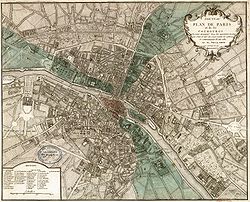Historical geography
This article needs additional citations for verification. (August 2012) (Learn how and when to remove this template message) |

Historical geography is the branch of geography that studies the ways in which geographic phenomena have changed over time. It is a synthesizing discipline which shares both topical and methodological similarities with history, anthropology, ecology, geology, environmental studies, literary studies, and other fields. Although the majority of work in historical geography is considered human geography, the field also encompasses studies of geographic change which are not primarily anthropogenic. Historical geography is often a major component of school and university curricula in geography and social studies. Current research in historical geography is being performed by scholars in more than forty countries.[1]
Themes[edit]
Historical geography seeks to determine how cultural features of various societies across the planet emerged and evolved by understanding their interaction with their local environment and surroundings.
Development of the discipline[edit]
In its early days, historical geography was difficult to define as a subject. A textbook from the 1950s cites a previous definition as an 'unsound attempt by geographers to explain history'.[2] Its author, J. B. Mitchell, came down firmly on the side of geography: 'the historical geographer is a geographer first last and all the time'. By 1975 the first number of the Journal of Historical Geography [3] had widened the discipline to a broader church: 'the writings of scholars of any disciplinary provenance who have something to say about matters of geographical interest relating to past time'.
For some[who?] in the United States of America, the term historical geography has a more specialized meaning: the name given by Carl Ortwin Sauer of the University of California, Berkeley to his program of reorganizing cultural geography (some say all geography) along regional lines, beginning in the first decades of the 20th century. To Sauer, a landscape and the cultures in it could only be understood if all of its influences through history were taken into account: physical, cultural, economic, political, environmental. Sauer stressed regional specialization as the only means of gaining sufficient expertise on regions of the world. Sauer's philosophy was the principal shaper of American geographic thought in the mid-20th century. Regional specialists remain in academic geography departments to this day. Despite this, some geographers feel that it harmed the discipline; that too much effort was spent on data collection and classification, and too little on analysis and explanation. Studies became more and more area-specific as later geographers struggled to find places to make names for themselves. These factors may have led in turn to the 1950s crisis in geography, which raised serious questions about geography as an academic discipline in the USA.
This sub-branch of human geography is closely related to history, environmental history, and historical ecology.[4]
List of historical geographers[edit]
Major institutions[edit]
- The Historical Geography Specialty Group of the American Association of Geographers
- The Historical Geography Research Group of the Royal Geographical Society
Major journals[edit]
References[edit]
- ^ Powell, Richard, and Robert M Wilson. “What Futures for the Pillar of Geography? a Report on the 16th International Conference of Historical Geographers, London.” Historical Geography 43 (2015).
- ^ Mitchell,J.B. Historical Geography (Hodder and Stoughton educational, 1954)
- ^ Journal of Historical Geography Volome 1, Number 1,1975
- ^ Balée, William (2006): The Research Program of Historical Ecology. In Annual Review of Anthropology 35 (1), pp. 75–98.
Further reading[edit]
- Catchpole, Brian. A Map History of the Modern World: 1890 to the Present Day. 1972 ed. Agincourt, Ont.: Bellhaven House, 1972. N.B.: First ed. published in 1968; an earlier revision with corrections appeared in 1970; partly an atlas of historical geography, partly an atlas illustrating historical events and trends. ISBN 0-88774-800-7
